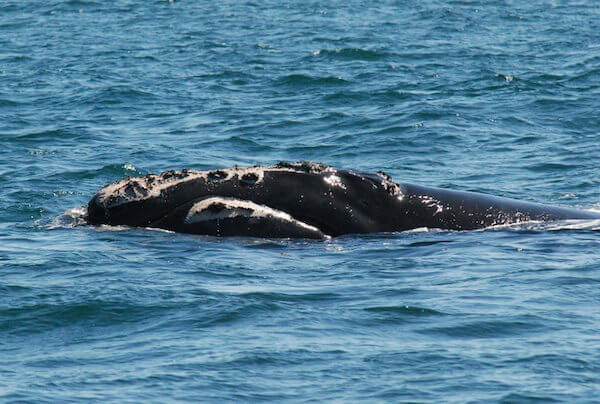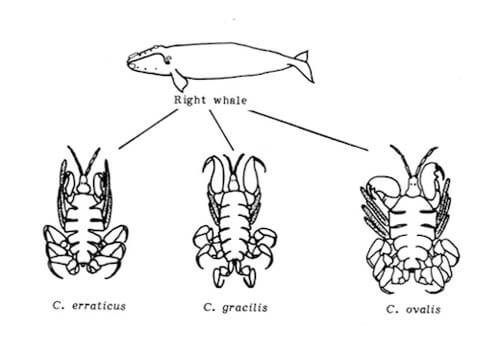By Sonia Villalon
The callosities in right whales are irregular patches of thickened and keratinized tissues. These tissues are habitat for three species of amphipod crustaceans specializing in right whales: Cyamis ovalis and Cyamis gracilis, which are white and are found on normal callosities in healthy individuals and, conversely, Cyamis erraticus, which is orange and is found in the wounds of sick or very young whales. These small crustaceans, also called whale lice or cyamids, feed on the whales’ skin. Incapable of swimming or surviving in the open water, they travel from one whale to another by direct contact.
Appearing at the end of the rostrum, on the lower lips and chin, above the eyes and in front of and behind the blowhole, callosities in right whales are congenital and are not caused by the external environment, as they are already present in the fetus and at various prenatal stages. However, they are not yet fully developed at birth and are not colonized by cyamids before individuals are several months old.The symbiosis between these cyamid species and the right whale is poorly understood by researchers. When describing a symbiosis, it is important to take note of the effect the interacation has on the species involved. For cyamids, the advantage of this symbiosis is evident since these callosities provide them with habitat and food resources. If these cyamids harmed their host, then it would be called parasitism, whereas if they had no effect on their host, it would be called commensalism.
Lastly, if they provided their host with a benefit, it would be called mutualism. Since these callosities are congenital, researchers question the selective advantage that the presence of cyamids on right whales might provide. Some believe that they may be involved in the species’ breeding strategy. It is known that males have a higher proportion of callosities than females. Also, males have already been observed scratching one another with their callosities. They might therefore be used by males during fighting for access to females. However, this theory is not unanimous, as females also have callosities. This is why some researchers believe that this might be an optional defence against predators for individuals of both sexes.
At the present time, due to the lack of evidence of a potential positive or negative effect of this symbiosis, cyamids are considered to be commensals, that is to say, they benefit from this symbiosis without weakening or harming their host. In conclusion, the function of callosities in right whales remains a mystery.
Note: The shape, size and location of these callosities are unique to each individual and are therefore a sort of fingerprint that allows researchers to photo-ID them.
Pour en savoir plus
- Payne R, Brazier O, Dorsey E, Perkins J, Rowntree V, Titus A (1983) External features in southern right whales (Eubalaena australis) and their use in identifying individuals. In: Payne R (ed) Communication and behaviour of whales. Westview Press, Boulder, pp 371–445
- William F. Perrin, Bernd Würsig and J.G.M. Thewissen (2009), Encyclopedia of Marine Mammals (Second Edition), (ISBN: 978-0-12-373553-9) page 965.






